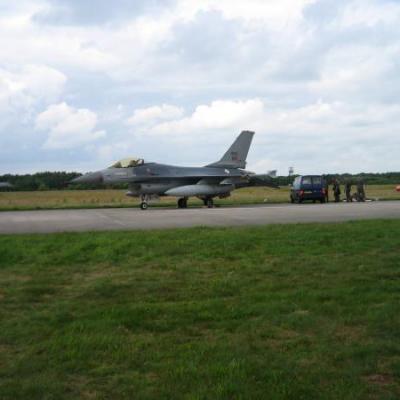Pilot (Piloot)
Information on this skill...
A pilot is a driver of an aircraft or other type of airship. Other names for pilot are aviator or airline pilot. Depending on the activities and the authority, there may be other names. Think of the name co-pilot, first officer and captain. These designations indicate the relationship of authority in the cockpit. The captain is the highest pilot in rank after which the first officer comes. Despite the fact that many people have had the childhood dream of becoming a pilot, becoming a pilot is not easy. To become a pilot, a costly training is needed, which most pilots pay off later during their employment. To be eligible for pilot training, you must have the right prior education and you will have to undergo a medical examination. This medical examination also covers various psychological tests. Pilot should be seen as a general name for aviators, because there are several pilots. For example, flying airliners cannot simply be compared to flying cargo planes or flying as a hobby. In all cases, a pilot is responsible for flying safely, but the profession of pilot has different degrees and powers. It is not the case that pilots are allowed to fly in all aircraft. The profession of pilot can be regarded as a beautiful profession, in which you do have to deal with great responsibilities. Because a pilot is burdened with great responsibilities, not everyone can just become a pilot. A pilot must have unique skills and competencies to be able to work as a pilot. The profession of pilot consists not only of being able to control an aircraft but of many more parts, such as knowing the technique, reading maps, dealing with weather situations, communicating with air traffic control and mastering the English language.
A pilot is therefore a driver or driver of an aircraft or other types of airship. Think, for example, of astronauts and helicopter pilots, who are classified as pilots. A balloonist cannot be considered a pilot, because a balloonist cannot fly a hot air balloon. As a pilot you usually work as a cargo pilot or as an airline pilot. In all cases, pilots face great responsibilities. A pilot must be a stable person, who can keep his head cool under all circumstances. Before a pilot will take off, the pilot will go through the flight plan together with the co-pilot and test all instruments. Maintaining contact with air traffic control is also a task of the pilot and co-pilot. During the flight, the pilot and co-pilot will go through numerous procedures to make the flight run smoothly. Even after landing, various procedures must be reviewed and all findings are recorded in a logbook. Pilots no longer have to deal with a flight engineer, as was the case in the past. Because safety plays an important role, pilots are exposed at least four times a year in a flight simulator to possible situations that may occur while flying. The flight simulator is programmable for hundreds of errors that can occur while flying, such as an engine that fails. Another example is the cabin pressure, which suddenly disappears. In this way, pilots learn to deal with difficult situations in a good way, so that pilots are also well prepared for possible emergencies in practice.
BECOME A PILOT
Becoming a pilot is only possible by following a pilot training. To be able to follow a pilot training, you must be at least seventeen years old and have a preliminary education of at least HAVO level with mathematics, physics and English in the package. While completing the admission, it will be checked whether you are suitable to work as a pilot. Think of a medical test and investigating whether you have an aptitude for the pilot profession. Wearing glasses is no longer a problem nowadays, provided that the eye defect is not too large. Anyone who aspires to a career as a pilot would be wise to start pilot training at a young age, in order to have a good chance as a pilot.
WORKING AS A PILOT
As a pilot, you can work for an airline or the Air Force. For most pilots it is a dream to be able to fly on a Boeing 747 or Airbus A320 right away. However, this hardly occurs in practice, and pilots usually start on smaller aircraft after their training, so that they can first gain experience. A pilot must first obtain the correct papers for another type of aircraft before the pilot can fly the aircraft. Getting to know an aircraft is quite a task for most pilots. Modern aircraft are so extensive and complicated that it often takes a longer period of time for a pilot to have knowledge of all the systems. A pilot can only fly safely if he knows all the systems and knows exactly how an aircraft works and how it behaves while flying. There are many pilots today, all of whom want to work for the major airlines. In practice, new pilots often start abroad or, for example, fly around post in Canada to build up sufficient experience and to get flying hours. Building up sufficient flight hours is important to qualify for more responsibilities.
DAILY LIFE OF A PILOT
A pilot can fly within Europe or fly all over the world. If the pilot flies within Europe, he will be at home more often than if the pilot has to fly to Asia. During a long flight, the pilots are no longer allowed to fly back due to the strict rules. Usually, pilots are given a few days off before flying back home. During these rest days, the pilots will stay in a hotel together with the other crew members, such as the flight attendants, the stewards and the purser. A pilot can therefore be away from home a lot, so that he is not with the family. A pilot flying within Europe will be home almost every night. Most flights to holiday countries go early in the day, so that the pilot is home in the evening.
PASSION TO FLY
Flying has a great attraction for many people. Most people only fly when they go on holiday. A pilot sits behind the bat almost daily and has the best view of all passengers on board. It's fantastic to leave an airport on a rainy day only to land in a sunny country after a few hours. As a pilot, you also have to deal with other employees who work within the aviation sector. Think, for example, of aircraft mechanics, aircraft cleaners, baggage handlers and marshallers.
WHAT DOES A PILOT DO:
PILOT TRAINING
There are various training opportunities for pilots. In the Netherlands, most airline pilots follow the training at the KLM Flight Academy (KLS). Pilot training takes about two years. There are also possibilities to be trained as a pilot through a bachelor's degree, by choosing one of the following directions: Aviation in Amsterdam, aviation technology or technical business administration. The pilot's license is not paid for by the school and will therefore have to be paid for itself. In order to be admitted, the student will have to go through a selection procedure. The selection includes a medical examination, psychological examination, flight simulator test and a general examination of your abilities. To be able to register for the programme, you must be at least seventeen years old and your previous education must meet the following requirements: at least HAVO with mathematics, physics and English. In order to have a chance at a job with the well-known major airlines, a pilot must have made at least 2500 flight hours. By the end of the flight training, a pilot will have made approximately between 150 and 200 flight hours.
COMPANIES WHERE A PILOT CAN BE EMPLOYED
In most cases, a pilot works for an airline. This can also be for an airline that operates as a cargo carrier. In addition, a pilot can work for the police, inspection services, defense or the fire department. Pilots can also work for companies, which fly on private jets. In that case, you usually have to deal with influential people, such as artists, ambassadors, ministers or directors.
COMPETENCES PILOT
The most important competence of a pilot is that you have a sense of responsibility. The safe transport of people and cargo is the core task of a pilot. In addition, communication can be regarded as an important competence, because clear communication has everything to do with preventing unsafe situations. Another important competence is that a pilot must have managerial abilities. Generally important words are passion, motivation, energy, flexibility, stress resistance, discipline, precision, control, monitoring, decisiveness, planning, organizing, independence, cooperation, consultation and dutiful.
LABOUR MARKET PERSPECTIVE AND CAREER OPPORTUNITIES AS A PILOT
The labour market perspective of a pilot is good. It is true that most pilots want to work for the well-known and larger airlines. This can make it difficult to obtain work, because the available workplaces are limited. In general, pilots find work fairly quickly after their training. It is possible that a pilot works for a lesser-known airline. Not all pilots work as airline pilots, because there are also pilots who work for cargo carriers. The career opportunities of a pilot can be seen in being allowed to fly on the larger aircraft or gaining more responsibilities. In that case, the position of captain can be seen as a possible career opportunity. It also happens that pilots sooner or later look for other jobs within the aviation sector, such as in air traffic control.
TERMS OF EMPLOYMENT AND SALARY PILOT
There are no examples of the working conditions, because a pilot can work for different airlines. However, there are strict rules that everyone must adhere to in terms of working hours, flight hours, training and safety. A novice pilot will earn a salary between 3000 and 8000 euros gross per month, depending on age, education and further responsibilities. A captain of a Jumbo 747 or an Airbus A380 can easily achieve an annual salary of 200,000 euros gross at the end of the career.
The content on this page has been automatically translated from the Dutch language. For this reason, texts and videos on this page may contain small errors.
Lesen Sie diese Informationen auf Pilot auf Deutsch.
Lea esta información sobre Piloto en español.
Lees deze informatie over Piloot in het Nederlands.
Mijnzzp.nl


